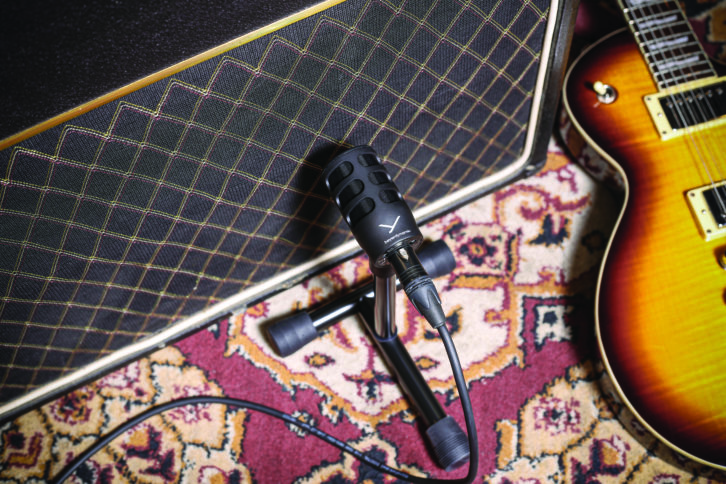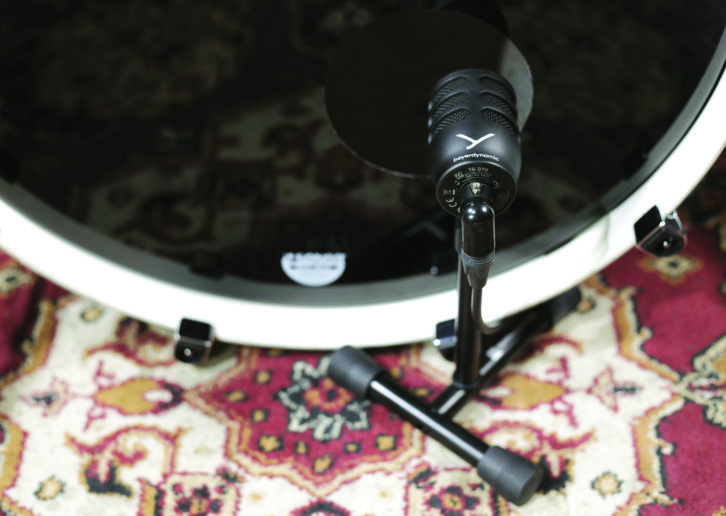
The Touring Gear Series from beyerdynamic is a well-established line of microphones popular for use not only on stage but also in the studio. A variety of TG mics are available for applications including vocals, instruments and of course drums. The most recent additions to the TG Series are the TG D70 kick drum microphone and the TG 151 instrument microphone.
Both models utilize dynamic transducers and housings constructed from die-cast zinc. They were designed to handle high SPLs at close proximity while rejecting unwanted ambient noise on loud stages. As with all TG Series microphones the TG D70 and TG 151 are built by hand at the beyerdynamic factory in Heilbronn, Germany. Mix received one TG D70 and three TG 151 microphones for this review.
The TG D70 is intended for use on kick drum, but it’s also effective on other instruments having low-frequency content, such as bass amp, horns and percussion. Its pressure-gradient capsule is a variation of the capsule used in the classic beyerdynamic M88 TG, a vocal microphone adopted by many engineers for use on kick drum and bass amp. The TG D70’s hypercardioid capsule is mounted on an internal elastic suspension, isolating it from mechanically transmitted noise. Frequency response is stated as 20 Hz to 14,000 Hz (40 Hz to 14,000 Hz at 1 meter), and nominal impedance is 280 ohms.
The TG 151 features a pressure-gradient capsule with a cardioid pickup pattern; it was developed for use on a wide variety of instruments, including snare drum, toms, electric guitar, horns and wind instruments. Frequency response of the TG 151 is stated as 33 Hz to 19,000 Hz measured at 2 centimeters (80 Hz to 19,000 Hz at 1 meter), with broad bumps of roughly 9 dB at 100 Hz, 5 dB at 5 kHz and 9 dB at 10 kHz. Nominal impedance is said to be 600 ohms. As with the TG D70, the pivoting mic stand adapter for the TG 151 is mated directly to the body of the microphone.
BEAUTY ISN’T JUST SKIN DEEP
The TG D70 and TG 151 are good-looking microphones with a solid feel. I’ll get my gripe out of the way now: the threaded mic stand mounts are made from plastic, and in my experience it’s only a matter of time until the threads strip. It would be wise to use quick-connect mic stand adapters to avoid that issue.
I put the TG D70 and TG 151 through the paces, initially using the TG D70 on kick and the TG 151s on snare, rack toms and floor toms for studio sessions. The low-profile package makes the mics easy to place; using cables with 90-degree connectors enabled them to fit into the smallest of spaces. The TG D70 and one TG 151 were plugged into a Great River MP2-NV for kick and snare, while the other two TG 151s were routed through an Avalon AD2022 for rack and floor toms.
The TG D70 was a bit of a surprise on kick drum. I was expecting another smiley-face-pre-EQ’d kick sound, but the TG D70 produced an un-hyped sound somewhat reminiscent of the AKG D12E. A look at the frequency curve of the TG D70 shows a fair amount of proximity effect; when compared to kick mics that mirror the current trend, the TG D70 has less bottom and a more forward midrange, giving it a tight, focused sound. This voicing may not be to everyone’s liking, particularly those seeking a kick sound that’s “finished” for a pop, rock or post-rock mix (more on this below).
I experimented with the position of the TG D70 relative to a hole in the front head of the kick drum. When positioned so that the front of the mic was flush with the hole, the kick sounded somewhat retro but still had a lot of impact. Moving the front half of the mic past the hole (into the drum) yielded more punch, and adding a bit of EQ at 80 Hz rounded out the low end nicely.
Adjusting the TG D70 so that the entire body of the mic sat just inside the hole was the money spot. The bottom end opened up but was still controlled, and the attack of the beater on the head was great. Moving the mic closer to the beater head produced more attack, at the expense of a reduction in the bottom end.
Similarly, the TG 151 produced a sound on snare and toms that pointed toward the more natural side of the meter. A/B’d with an Audix i5 on snare, the i5 captured more of the lower-mids, while the TG 151 brought out more of the high end.
This characteristic was also evident on rack and floor toms, where the TG 151 was controlled in the bottom end and grabbed a great representation of stick-on-head. Moving the TG 151 real close to the head gives a bit of proximity effect, but it’s not as pronounced as it would be using other mics. You can place the mics very close to reduce leakage while not turning the low end into mud.

ROAD TEST ON STAGE
Taking the TG D70 and 151 out for a few live shows provided interesting results. Output from both mics were noticeably hot by as much as 10 to 12 dB (apparent when recalling FOH and monitor scenes on digital consoles; gain for the TG mics had to be reduced considerably). My monitor engineer liked this characteristic because it meant less gain at the preamp, which reduced noise that might otherwise be heard through IEM mixes.
When running the TG D70 through a concert P.A., I was expecting the same sort of midrange-forward sound that I heard in the studio, but the TG D70 combined with the P.A. to produce a kick sound that had plenty of bottom, yet wasn’t sloppy. Engineers looking for that Big Badass Kick Drum Sound may need to add some low end, but I don’t like that sort of bottom end on a kick when mixing Blue Öyster Cult because it overshadows the band’s arrangements. I added a bit of EQ—plus a few dB at 1.75 kHz for some smack, and a pinch down at 280 Hz—and the kick sounded sweet. It fit perfectly into the mix, delivering the impact I needed without becoming overbearing. As a bonus, there was little bleed from the other instruments, including the bass amp.
Meanwhile, the TG 151 that I used on snare performed like a champ and was easy to place exactly where I wanted it. I added a dB or two at 5 kHz to open the top end a bit, and cut a few dB at 300 Hz to tame the low-mids, giving the snare a crisp, articulate sound with plenty of presence. I liked the fact that leakage of the hi-hat in the snare mic was negligible.
I also had the chance to use the TG 151 on electric guitar (Marshall 4×12) alongside a few other microphones, and the results were revealing. When the guitar player cranked the amp, the TG 151 was a clear winner; it easily handled the high SPL and in fact seemed to excel at high SPLs. On a medium-volume metal guitar sound, the TG 151 was aggressive-sounding, especially when the highest frets on the guitar were played—too much for my taste, but I could definitely see the application for it.
The TG 151 also had the edge over the other mics when the guitarist played finger-picked parts, producing clear upper-mids and well-defined low-mids. Comparing the TG 151 to the TG D70 on floor tom, the TG D70 produced a deeper tone and captured more of the drum’s fundamental than did a TG 151.
The TG 151 showed its versatility when I grabbed it in a pinch to use for a voiceover. It worked out great: clear, natural and articulate with just the right amount of proximity bump. I needed a pop screen to reduce popping “Ps,” but I wouldn’t hesitate to use the combination again in the future for voice work.
The number of high-quality microphones on the market is staggering, but—by not voicing them as “me too” microphones—beyerdynamic has found a niche for the TG D70 and TG 151. Both models produce uncolored sound with unique voicings for your sonic palette, and they are well-constructed, reasonably priced and fit into tight spaces. Definitely worth an audition!
PRODUCT SUMMARY
Company: beyerdynamic
Product: TG D70 Dynamic Kick Drum Microphone; TG 151 Dynamic Instrument Microphone
Website: www.beyerdynamic.com
Price: TG D70: $249; TG 151: $129
Pros: Robust construction; not the same old flavor (both models); controlled low-frequency response (TG D70); useful on a variety of instruments (TG 151)
Cons: Stand adapter has a plastic thread







